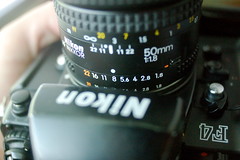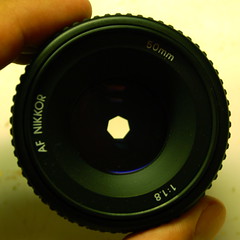Penmachine
22 November 2008
Camera Works: intermediate f-stop values
 The aperture and f-stops article in my ongoing Camera Works series has been popular, but it has also raised some questions. Here's one from Mike S.:
The aperture and f-stops article in my ongoing Camera Works series has been popular, but it has also raised some questions. Here's one from Mike S.:
How much ISO would I gain?
I just read your blog on f-stops. Very informative and I learned things I had given up on. I do have a question. Keep in mind I'm not mathematically inclined. I am trying to figure out how much ISO I would gain, meaning lower ISO, if I shot at a 1.8 setting versus a 2.8? I currently only own 2.8 lenses and find myself shooting indoor sports at ISO 3200 at about a 320th of a second. My goal is to get the ISO to 1600 or lower while keeping the 320 [shutter speed] as a minimum. How would I figure this out? I wasn’t sure if 2.8 was double 1.8.
My answer is that lens at f/1.8 does not let in double the light of a lens at f/2.8: it lets in more than that. About 2.4 times as much light, in fact. We'll see why below.
As I described in that original article in August, the sequence of full stops runs in multiples of 1.4 (actually the square root of 2, which is 1.41421356..., but close enough), so if you start at f/1, you have:
1, 1.4, 2, 2.8, 4, 5.6, 8, 11, 16, 22, 32, 45, 64
(You won't see f/45 or f/64 on normal SLR or point-and-shoot lenses, but they're not uncommon on large-format cameras.)
Each of those values lets in half the light of the stop to the left, and twice the light of the stop to the right. So in Mike's case, using a lens that can open to f/2 instead of f/2.8 will let him use either twice the shutter speed or half the ISO (light sensitivity) setting. But what about f-stops that don't fit that sequence, like f/1.8 or f/3.3?
Figuring out intermediate f-stops
This takes simple real-world f-stop math, but it's just multiplying and dividing, so it's not hard. The old area-of-a-circle equation (πr2) gives you the answers:
- If you're at f/2.8, the diameter of your aperture is 1/2.8 the focal length of the lens (or about 0.357 the focal length).
- If you're at f/1.8, the aperture is bigger, 1/1.8 (or about 0.556 the focal length).
- The ratio of the two aperture diameters, 0.556 to 0.357, is about 1.56 (just divide 0.556 by 0.357), so f/1.8 is about 1.56 times wider than f/2.8. (You could actually do this more simply: 2.8 divided by 1.8 gives you the same number, about 1.56.)
- From that area-of-a-circle equation, since the area (and the light let through) changes by the square of the diameter (or radius, it doesn't matter in this case) of the aperture, simply square that ratio value (1.562) to get about 2.4.
- So f/1.8 lets in about 2.4 times more light as f/2.8, and f/2.8 lets in about 2.4 times less light than f/1.8.
What does that mean?
Here's how you can use that knowledge:
- If you stay at ISO 3200 and it works at 1/320 of a second at f/2.8, you can shoot 2.4 times faster if you go to f/1.8, which would be (320 x 2.4) or 1/768 sec (or 1/750, rounded to the nearest realistic camera shutter speed).
—or— - If you're adjusting ISO and keep the shutter speed fixed, you can shoot at 3200 divided by 2.4, or ISO 1333 (more like 1250 in real-world terms) if you click from f/2.8 to f/1.8.
This reveals something. In the old days of film, photographers used to think in terms of two variables: shutter speed and aperture. That's because the third one, sensitivity or ISO (also known previously as ASA), was fixed for each roll of film. You had an ISO 400 roll, or an ISO 64 roll, or a high-speed ISO 1000 roll, but that was it until you changed the film.
In the digital age, we now have that third variable, because we can adjust the ISO as much as we want, or even have the camera adjust it automatically for changing lighting conditions, so that each picture can use its own ISO setting, as well as its own aperture and shutter speed.
The simple version
 All right, so here is the simplified version of what to do when you want to know how two different f-stops affect ISO and shutter speed:
All right, so here is the simplified version of what to do when you want to know how two different f-stops affect ISO and shutter speed:
Divide the bigger f-stop number by the smaller one (2.8 divided by 1.8, for example) to get the ratio of their diameters. Then square the result to find out the ratio of light let through. Next, multiply or divide your shutter speed or ISO by that value to figure out how you need to adjust it.
Or let your camera's meter figure it out!
The nice part is that while you have to square the aperture ratios to determine how much light is let through, shutter speed and ISO simply multiply or divide by 2: 1/500 sec lets in half the light of 1/250, and ISO 3200 captures twice the light of ISO 1600, so the rest of the math is straightforward
Another example
- I'm at f/3.3 at 1/2000th of a second at ISO 200 and I stop down to f/16 because I want more depth of field.
- 16 divided by 3.3 is about 4.85.
- 4.85 squared is about 23.5, so F/16 brings in 23.5 times less light than f/3.3.
- So I need a shutter speed 23.5 times slower to let in the same amount of light. 2000 divided by 23.5 is about 85.1, so I need 1/85 of a second (or 1/90, rounding off for most cameras) to get the same exposure.
- Or I can adjust the ISO: 200 times 23.5 is ISO 4700, and I can still shoot at 1/2000. I'll need a pretty new, high-end DSLR to get that high an ISO value, but it is possible.
- You can also combine things. If I decide to shoot at 1/1000 of a second, I can halve the ISO to 2350 at f/16, more in the range of regular cameras these days. Many won't let you set the ISO to incremental values like that manually, but they will do it in Auto ISO modes that keep shutter speed and aperture fixed and adjust ISO to match the exposure, as I mentioned above.
When you spin the aperture dial on your camera and see intermediate values—or if you have a lens with a physical aperture ring with clicks in between the full-stop values and a maximum aperture not on that scale, like f/3.5, f/4.5, or f/6.3—now you know what those values represent.
One stop can be expensive
People taking sports photos typically use a zoom or telephoto lens with a focal length of 200 mm or so. You can buy a very nice 70-200 mm zoom that opens to f/2.8 from Canon, Nikon, and others for between $700 and $1700 USD. Not cheap, but worth it if that's what you need to do.
But if you want a 200 mm lens that opens one stop wider, to f/2? Nikon and Canon make them. They're huge, and will set you back something like $5000. Back in the '80s Nikon even made a 300 mm f/2 lens. List price? $29,000.
Modern digital cameras with good performance at high ISO sensitivity, and lenses with image stabilization, now make it possible to get similar results (one stop faster) for much, much less money.
« Previous: shutters and flashes
Labels: barcamp, cameraworks, geekery, photography
Comments:
So far, no joy.


